|
Moravian Instruments Cx CMOS line and Gx CCD line of astronomical
cameras are designed with maximum image quality on mind. Camera bodies
are compact and robust, CNC manufactured from solid aluminum.
Small C1 cameras are intended as autoguiders as well as Moon, Sun
and planetary imagers. Cameras are powered from USB connection and
offer very high FPS, allowed by usage of USB3.
C1+ and C1× cameras employ active
cooling and greater sensors, but still offer compact and symmetrical
design, especially suitable for primary focus. C1+ can be powered from
USB only, but active sensor cooling is available only if external
power is connected. C1× cameras require
external power to operate.
Cooled C2, C3, C4 and C5 cameras are powered from external
12 V DC
power supply. These models are equipped with mechanical shutter and
precise regulated cooling. All these models can be connected to
external filter wheels, Off-Axis Guiders, various telescope and lens
adapters and other accessories. C2 and C3 cameras can be also equipped
with internal filter wheel, which makes them very compact,
all-containing devices.
Cx cameras are equipped with 5 Gbps USB 3.0 interface, fully
backward compatible with 480 Mbps USB 2.0 connections. Up to four
cameras of all types can be connected to the Moravian Camera Ethernet
Adapter to access them through 1 Gbps
Ethernet and TCP/IP protocol from virtually unlimited distance.
C5 CMOS cameras
C5 camera series is designed to accommodate the
latest generation of extremely large Sony IMX CMOS sensors with
100 and 150 MPx resolution and
diagonal dimension up to 67 mm. Many
of the used sensor properties share the exceptional features of
the sensors used in the C3 series, including the
3.76 μm pixel size with the full-well capacity
exceeding 50 ke-, very high
quantum efficiency thanks to back-illuminated design and
very low dark current. C5 sensors also offer
16 bit digitization,
perfectly linear response to light and exceptionally
low read noise.
C5 cameras are made in two versions: Asymmetrical version
marked C5A and Symmetrical version marked C5S. Both cameras may be
equipped with GPS receiver for precise exposure timing.
Asymmetrical C5A variant look reveals the same
time-proven design school of the C3 and C4 series in both outer
shape and internal construction. The front cross-section of the
C5A cameras is the same as the C3 and C4 series, although the used
sensors are much larger. C5 head thickness corresponds to the
thickness of the Enhanced Cooling versions of the earlier models.
Asymmetrical models also employ mechanical shutter, allowing to
capture dark or bias frames without a necessity to cover the
telescope aperture.
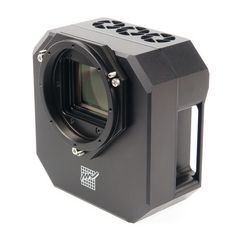 |
| Model |
CMOS sensor |
Resolution |
Pixel size |
Image area |
| C5A-100M |
IMX461 |
11664 × 8750 |
3.76 × 3.76 μm |
43.86 × 32.90 mm |
| C5A-150M |
IMX411 |
14208 × 10656 |
3.76 × 3.76 μm |
53.42 × 40.07 mm |
|
C5A series CMOS cameras Symmetrical C5S variant main purpose is not to exceed
the central obstruction of reflecting telescopes with the camera
located in the primary focus. The asymmetrical variant typically
overhangs the central obstruction of smaller telescopes (with
~0.4 m primary mirror diameter),
despite the central obstruction of wide-field telescope is rather
big. Due to mechanical constrains, the symmetrical model lacks the
mechanical shutter. The symmetrical variant also contains hardware
trigger input, not available on the asymmetrical cameras.
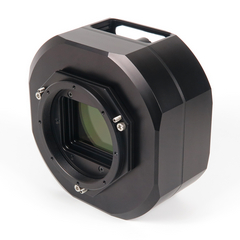 |
| Model |
CMOS sensor |
Resolution |
Pixel size |
Image area |
| C5S-100M |
IMX461 |
11664 × 8750 |
3.76 × 3.76 μm |
43.86 × 32.90 mm |
| C5S-150M |
IMX411 |
14208 × 10656 |
3.76 × 3.76 μm |
53.42 × 40.07 mm |
|
C5S series CMOS cameras C4 CMOS cameras
The C4-16000 cooled scientific CMOS camera sensors
offer the same geometry like the CCDs in the famous G4-16000
cameras — sensor size 37 × 37 mm, 9 μm pixels and 16 MPx
(4k × 4k) resolution. Also the
mechanical design of C4 cameras inherits from G4 Mark II cameras,
which makes the C4 camera line fully compatible with vast range of
telescope adapters, off-axis guider adapters, filter wheels,
Camera Ethernet adapters, guiding cameras etc.
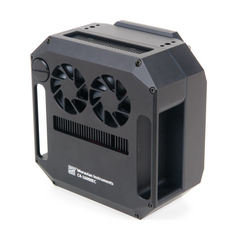 |
| Model |
CMOS sensor |
Resolution |
Pixel size |
Image area |
| C4-16000 |
GSENSE4040 |
4096 × 4096 pixels |
9 × 9 μm |
36.86 × 36.86 mm |
|
C4 series contains single model C3 CMOS cameras
C3 cameras employ the latest generation of Sony
IMX CMOS sensors, offering exceptional quantum efficiency thanks
to back-illuminated design and very low dark
current. Despite relatively small pixels, full-well capacity
exceeding 50 ke-. Combined
with full 16 bit
digitization and perfectly linear response to light
make these cameras suitable for both aesthetic astro-photography
as well as astronomical research. Sensor formats from APS to
photographic full-frame (24 × 36 mm) ensure
wide field of view and optimally utilize capabilities of the
optical systems most commonly used by amateur astronomers.
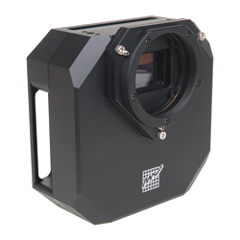 |
| Model |
CMOS sensor |
Resolution |
Pixel size |
Image area |
| C3-26000 |
IMX571 |
6252 × 4176 pixels |
3.76 × 3.76 μm |
23.51 × 15.70 mm |
| C3-61000 |
IMX455 |
9576 × 6388 pixels |
3.76 × 3.76 μm |
36.01 × 24.02 mm |
|
C3 series CMOS cameras C2 CMOS cameras
The cooled C2 series are offered with sensors with
global shutter as well as rolling shutter. CMOS
cameras were developed for imaging under extremely low-light
conditions in astronomy, microscopy and similar areas. Mechanical
design of this series inherits from earlier CCD-based G2 Mark II
cameras, which makes the C2 series fully compatible with vast
range of telescope adapters, off-axis guider adapters, internal or
external filter wheels, Camera Ethernet adapters, guiding cameras
etc.
The global shutter C2 CMOS camera series contains
models differing in pixel size and also digitization range.
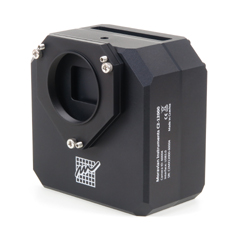 |
| Model |
CMOS sensor |
Resolution |
Pixel size |
Image area |
| C2-3000 |
IMX252 |
2064 × 1544 pixels |
3.45 × 3.45 μm |
7.12 × 5.33 mm |
| C2-5000 |
IMX250 |
2464 × 2056 pixels |
3.45 × 3.45 μm |
8.50 × 7.09 mm |
| C2-12000 |
IMX253 |
4112 × 3008 pixels |
3.45 × 3.45 μm |
14.19 × 10.38 mm |
|
Global shutter C2 cameras with both 8- and 12-bit
digitization 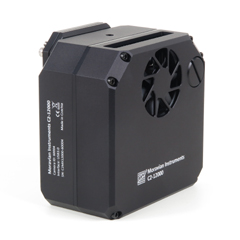 |
| Model |
CMOS sensor |
Resolution |
Pixel size |
Image area |
| C2-3000A |
IMX265 |
2064 × 1544 pixels |
3.45 × 3.45 μm |
7.12 × 5.33 mm |
| C2-5000A |
IMX264 |
2464 × 2056 pixels |
3.45 × 3.45 μm |
8.50 × 7.09 mm |
| C2-12000A |
IMX304 |
4112 × 3008 pixels |
3.45 × 3.45 μm |
14.19 × 10.38 mm |
| C2-7000A |
IMX428 |
3216 × 2208 pixels |
4.50 × 4.50 μm |
14.47 × 9.94 mm |
|
Global shutter C2 cameras with 12-bit digitization
only The rolling shutter C2 CMOS camera series currently
consists of single model with Sony IMX533 sensor with pixel size
3.76 × 3.76 μm:
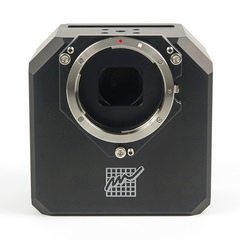 |
| Model |
CMOS sensor |
Resolution |
Pixel size |
Image area |
| C2-9000 |
IMX533 |
3008 × 3008 pixels |
3.76 × 3.76 μm |
11.31 × 11.31 mm |
|
Rolling shutter C2 cameras with 14-bit
digitization C1× CMOS cameras
C1× cameras employ
the same sensors like the C3 series — latest
generation of Sony APS and Full-Frame (24 × 36 mm) CMOS
sensors, offering exceptional quantum efficiency thanks to
back-illuminated design and very low dark
current. Despite relatively small pixels, full-well capacity
exceeding 50 ke-. Combined
with full 16 bit
digitization and perfectly linear response to light
make these cameras suitable for both aesthetic astro-photography
as well as astronomical research.
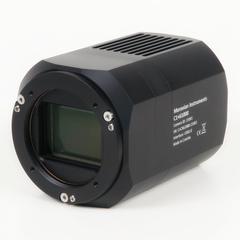 |
| Model |
CMOS sensor |
Resolution |
Pixel size |
Image area |
| C1×26000 |
IMX571 |
6252 × 4176 pixels |
3.76 × 3.76 μm |
23.51 × 15.70 mm |
| C1×61000 |
IMX455 |
9576 × 6388 pixels |
3.76 × 3.76 μm |
36.01 × 24.02 mm |
|
C1× series CMOS
cameras C1+ CMOS cameras
The cooled C1+ series global shutter CMOS
cameras are designed to fulfill the gap between small and
lightweight C1 models, intended as Moon and planetary cameras and
auto-guiders, and C2 cameras, equipped with active sensor cooling
and mechanical shutter and thus intended for more serious
astronomical imaging and research. C1+ cameras are able to work as
C1 ones, only being somewhat heavier and bulkier, and at the same
time C1+ can replace the C2 models, only with slightly less
cooling performance and lack of mechanical shutter.
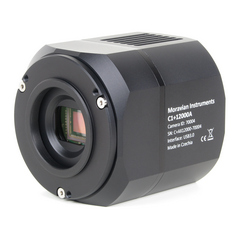 |
| Model |
CMOS sensor |
Resolution |
Pixel size |
Image area |
| C1+3000 |
IMX252 |
2064 × 1544 pixels |
3.45 × 3.45 μm |
7.12 × 5.33 mm |
| C1+5000 |
IMX250 |
2464 × 2056 pixels |
3.45 × 3.45 μm |
8.50 × 7.09 mm |
| C1+12000 |
IMX253 |
4112 × 3008 pixels |
3.45 × 3.45 μm |
14.19 × 10.38 mm |
|
C1+ cameras with both 8- and 12-bit
digitization 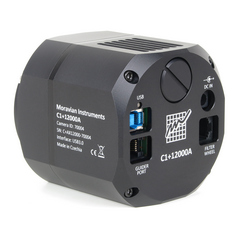 |
| Model |
CMOS sensor |
Resolution |
Pixel size |
Image area |
| C1+3000A |
IMX265 |
2064 × 1544 pixels |
3.45 × 3.45 μm |
7.12 × 5.33 mm |
| C1+5000A |
IMX264 |
2464 × 2056 pixels |
3.45 × 3.45 μm |
8.50 × 7.09 mm |
| C1+12000A |
IMX304 |
4112 × 3008 pixels |
3.45 × 3.45 μm |
14.19 × 10.38 mm |
| C1+7000A |
IMX428 |
3216 × 2208 pixels |
4.50 × 4.50 μm |
14.47 × 9.94 mm |
|
C1+ cameras with 12-bit digitization only C0 and C1 CMOS cameras
The C0 and C1 series global shutter CMOS
cameras were designed to be small, lightweight imagers for Moon
and planets and for automatic telescope guiding. With proper image
calibration, C0 and C1 cameras provide surprisingly good results
also in entry-level deep-sky imaging. The used CMOS sensors
response to light is linear up to very close to saturation point,
so, the C0 and C1 cameras can be used for scientific applications
like variable star research, too.
The C0 and C1 cameras share majority of features, like the used
sensors, USB interface, autoguider port, etc. At the first view,
the only difference is the size of camera body. But greater
dimensions of the C1 models allowed adding of some features, not
available on the C0 cameras, like cooling fan and mounting
threaded holes.
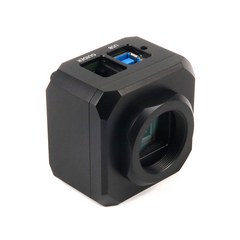 |
| Model |
CMOS sensor |
Resolution |
Pixel size |
Image area |
| C0/C1-1500 |
IMX273 |
1456 × 1088 pixels |
3.45 × 3.45 μm |
5.02 × 3.75 mm |
| C0/C1-3000 |
IMX252 |
2064 × 1544 pixels |
3.45 × 3.45 μm |
7.12 × 5.33 mm |
| C0/C1-5000 |
IMX250 |
2464 × 2056 pixels |
3.45 × 3.45 μm |
8.50 × 7.09 mm |
| C0/C1-12000 |
IMX253 |
4112 × 3008 pixels |
3.45 × 3.45 μm |
14.19 × 10.38 mm |
|
C0 camera; C0 and C1 models with both 8- and 12-bit
digitization 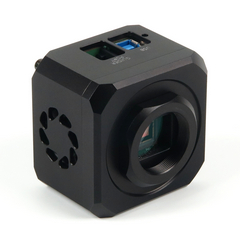 |
| Model |
CMOS sensor |
Resolution |
Pixel size |
Image area |
| C0/C1-3000A |
IMX265 |
2064 × 1544 pixels |
3.45 × 3.45 μm |
7.12 × 5.33 mm |
| C0/C1-5000A |
IMX264 |
2464 × 2056 pixels |
3.45 × 3.45 μm |
8.50 × 7.09 mm |
| C0/C1-12000A |
IMX304 |
4112 × 3008 pixels |
3.45 × 3.45 μm |
14.19 × 10.38 mm |
|
C1 camera; C0 and C1 models with 12-bit digitization
only External Filter Wheels for Cx and Gx CCD cameras
External Filter Wheels for Cx CMOS and Gx
CCD cameras offer more positions compared to internal filter
wheels, embedded into camera head. External filter wheel is not
connected to the host PC (with separate USB or serial cable) as
well as to separate power supply. Only single short 8-wire cable
connects the external filter wheel with the camera head. External
and internal filter wheels are indistinguishable from the software
point of view, same drivers are used to control them.
External filter wheels cannot be used together with internal
ones. The C2/G2 and C3/G3 cameras with internal filter wheel
cannot be attached to external filter wheel — the camera is manufactured either with internal
filter wheel or with connectors and thinner front case for
attaching of the external filter wheel. Because of the filter size
there is no internal filter wheel for C5 and C4/G4 cameras, these
cameras can be used only with external filter wheels.
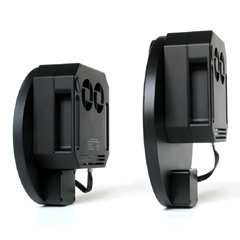 |
| Model |
Camera model |
Number of positions |
Filter dimensions |
| EFW-2XS-8 |
C2, C1+ |
8 |
D31 mm, 1.25" |
| EFW-2XS-7 |
C2, C1+ |
7 |
D36 mm |
| EFW-2S-12 |
C2, C1+ |
12 |
D31 mm, 1.25" |
| EFW-2S-10 |
C2, C1+ |
10 |
D36 mm |
| EFW-2S-7 |
C2, C1+ |
7 |
D50 mm, 2" |
| EFW-3S-7 |
C3, C1× |
7 |
D50 mm, 2" |
| EFW-3L-9 |
C3, C1× |
9 |
D50 mm, 2" |
| EFW-3L-7 |
C3, C1× |
7 |
50 × 50 mm |
| EFW-4M-7 |
C4 |
7 |
D50 mm, 2" |
| EFW-4M-5 |
C4 |
5 |
50 × 50 mm |
| EFW-4L-9 |
C4 |
9 |
D50 mm, 2" |
| EFW-4L-7 |
C4 |
7 |
50 × 50 mm |
| EFW-5XL-7 |
C5 |
7 |
50 × 50 mm |
| EFW-5XL-5 |
C5 |
5 |
65 × 65 mm |
|
Moravian Camera Ethernet Adapter
Moravian Camera Ethernet Adapter allows
connection of Cx and Gx series cameras to the control computer
using Ethernet interface and TCP/IP protocol stack (this means
over Local or Wide Area Networks). Single Moravian Camera Ethernet
Adapter contains up to four USB 3.0 or USB 2.0 ports and allows
connection of up to four Cx and Gx cameras at the same time
(regardless of the specific series, cameras can be freely
combined).
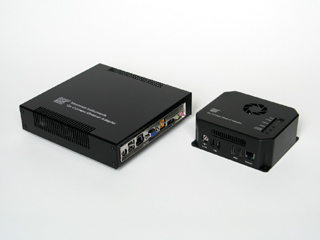 |
| Model |
Supported cameras |
Ethernet interface |
USB 2.0 ports |
USB 3.0 ports |
Power supply |
Dimensions |
| GxETHA |
C1 to C4, G0 to G4 |
1 Gbps, 10/100 Mbps |
0 |
4 |
12 V DC |
188 × 184 × 40 mm |
| GxETHA Micro |
C1 to C4, G0 to G4 |
1 Gbps, 10/100 Mbps |
4 |
0 |
12 V DC |
95 × 83 × 39 mm |
|
Off-Axis Guider
Off-axis Guider (OAG) adapters are designed to allow attachment
of any guiding camera with 1.25" eyepiece nose, although the nose
must be somewhat shorter to achieve focus. G0 cameras are designed
to achieve focus with Gx OAG and a special shorter version of
1.25" nose with C-mount thread is available for all G1 cameras.
Any camera with CS-mount (short version of C-mount standard) can
use this adapter to be attached to all variants of OAG
adapters.
Off-axis guider adapters for G2/C2 cameras are
equipped with standard M42 × 0.75
(T-thread) or M48 × 0.75 thread on
the telescope side in a proper 55 mm
back focal distance. This means G2 camera with OAG can be used on
numerous optical systems, including Newtonian coma-correctors,
refractor field flatteners etc.
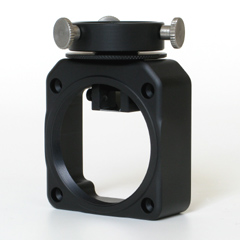 |
| Model |
Supported cameras |
Filter wheels |
Back focal distance |
Front thread |
Guider camera port |
| OAG-2-TT |
C1+ |
EFW-2XS, EFW-2S |
55 mm |
M42 × 0.75
(T-thread) |
1.25 " |
| |
C2 |
Internal, EFW-2XS, EFW-2S |
55 mm |
M42 × 0.75
(T-thread) |
1.25 " |
| OAG-2-M48 |
C1+ |
EFW-2XS, EFW-2S |
55 mm |
M48 × 0.75 |
1.25 " |
| |
C2 |
Internal, EFW-2XS, EFW-2S |
55 mm |
M48 × 0.75 |
1.25 " |
| |
C1x |
EFW-2S |
55 mm |
M48 × 0.75 |
1.25 " |
| |
C3 |
Internal, EFW-2S |
55 mm |
M48 × 0.75 |
1.25 " |
|
Usage of the OAG-2 is limited to C1×26000 and C3-26000 models only. Full frame
61000 model sensor is too big for OAG-2
Off-axis guider adapters for G3/C3 and G4/C4
cameras are equipped with M68 × 1 thread on the telescope side in the
distance 61.5 mm from the detector.
Two variants (for C3 cameras and for C4 cameras) differ in the
mounting holes placement and also in the distance of the
reflecting mirror from the optical axis.
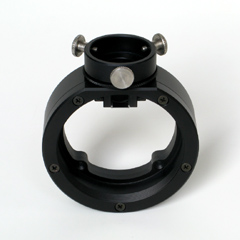 |
| Model |
Supported cameras |
Filter wheels |
Back focal distance |
Front thread |
Guider camera port |
| OAG-3-M68 |
C3 |
Internal, EFW-3M, EFW-3L |
61.5 mm |
M68 × 1 |
1.25 " |
| OAG-4-M68 |
C4 |
EFW-4M, EFW-4L |
61.5 mm |
M68 × 1 |
1.25 " |
|
Off-axis guider adapters for C5 cameras offers
M85 × 1 thread on the telescope side
in the distance 61.5 mm from the
detector.
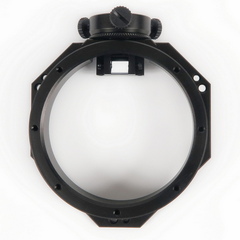 |
| Model |
Supported cameras |
Filter wheels |
Back focal distance |
Front thread |
Guider camera port |
| OAG-5-M85 |
C5 |
EFW-5XL |
61.5 mm |
M85 × 1 |
1.25 " |
|
Camera control and image processing software SIPS
Powerful SIPS (Scientific Image Processing System)
software, supplied with the camera, allows complete camera control
(exposures, cooling, filter selection etc.). Also automatic
sequences of images with different filters, different binning etc.
are supported. With full ASCOM standard support, SIPS can be also
used to control other observatory equipment. Specifically the
telescope mounts, but also other devices (focusers, dome or roof
controllers, GPS receivers etc.).
SIPS also supports automatic guiding, including image
dithering. Both “autoguider” port hardware interface
(6-wire cable) and mount “Pulse-Guide API” guiding methods
are supported. For hi-quality mounts, capable to track without the
necessity to guide at last during one exposure, inter-image
guiding using the main camera only is available.
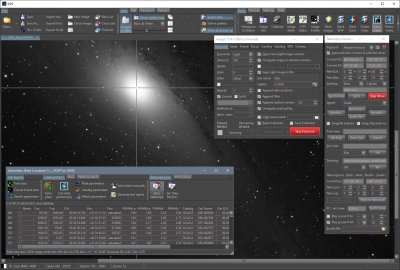
SIPS controlling whole observatory (shown in optional
dark skin) But SIPS is capable to do much more than just camera and
observatory control. Many tools for image calibration, 16 and
32 bit FITS file handling, image set
processing (e.g. median combine), image transformation, image
export etc. are available.
SIPS handles FITS files, supports image calibration and
processing As the first “S” in the abbreviation SIPS means
Scientific, the software supports astrometric image reduction as
well as photometric processing of image series.
SIPS focuses to advanced astrometric and photometric
image reduction, but also provides some very basic
astro-photography processing SIPS software package is freely available for download from this www site. All functions are
thoroughly described in the SIPS User's Manual, installed with
every copy of the software.
Drivers for other software packages
Drivers for ASCOM standard as well as native drivers for
third-party software are also available (e.g. TheSkyX, MaxIm DL,
AstroArt, etc.). Visit the download page of this web site for current list
of available drivers, please.
Also INDI drivers for 32 bit and
64 bit Linux running on x86 and ARM
are available. Also drivers for TheSkyX package running on macOS
are supplied with the camera.
| 